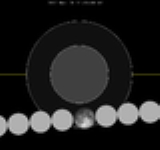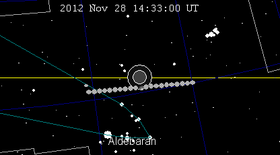
November 2012 lunar eclipse
Encyclopedia
| Penumbral Lunar Eclipse November 28, 2012 |
|
|---|---|
 The northern parts of the moon will perceptibly dim as the moon passes through the Earth's penumbral shadow |
|
| Series (and member) Saros cycle The saros is a period of 223 synodic months , that can be used to predict eclipses of the Sun and Moon. One saros after an eclipse, the Sun, Earth, and Moon return to approximately the same relative geometry, and a nearly identical eclipse will occur, in what is referred to as an eclipse cycle... |
145 (11 of 71) |
| Duration (hr:mn:sc) | |
| Penumbral | 4:35:59 |
| Contacts | |
| P1 | 12:14:59 UTC |
| Greatest | 14:32:59 UTC |
| P4 | 16:50:59 UTC |
 The moon's hourly motion across the Earth's shadow in the constellation of Taurus Taurus (constellation) Taurus is one of the constellations of the zodiac. Its name is a Latin word meaning 'bull', and its astrological symbol is a stylized bull's head:... |
|
A penumbral lunar eclipse
Lunar eclipse
A lunar eclipse occurs when the Moon passes behind the Earth so that the Earth blocks the Sun's rays from striking the Moon. This can occur only when the Sun, Earth, and Moon are aligned exactly, or very closely so, with the Earth in the middle. Hence, a lunar eclipse can only occur the night of a...
will take place on November 28, 2012, the second of two lunar eclipses in 2012.
Visibility

A simulated view of the earth from the center of the moon at maximal eclipse
Lunar year (354 days)
This eclipse is the one of four lunar eclipses in a short-lived series. The lunar year series repeats after 12 lunations or 354 days (Shifting back about 10 days in sequential years). Because of the date shift, the Earth's shadow will be about 11 degrees west in sequential events.See also
- List of lunar eclipses and List of 21st century lunar eclipses
- :File:2012-11-28 Lunar Eclipse Sketch.gif Chart

